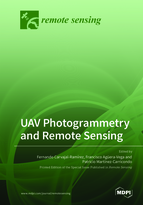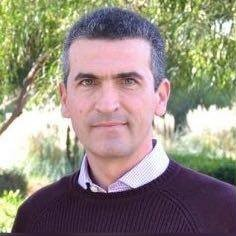UAV Photogrammetry and Remote Sensing
A special issue of Remote Sensing (ISSN 2072-4292).
Deadline for manuscript submissions: closed (31 March 2021) | Viewed by 77814
Special Issue Editors
Interests: UAV photogrammetry applied to remote sensing of natural resources
Special Issues, Collections and Topics in MDPI journals
Interests: UAV photogrammetry and UAV geomatics applied to natural resources study
Special Issues, Collections and Topics in MDPI journals
Interests: UAV photogrammetry applied to remote sensing of natural resources and civil engineering
Special Issues, Collections and Topics in MDPI journals
Special Issue Information
Dear Colleagues,
Photogrammetry based on Unmanned Aerial Vehicles (UAV photogrammetry) is an irruptive technology that is being applied to obtain very-high-resolution Digital Surface Models, orthoimages, and point clouds which represent terrain morphology.
Most of the research issues related to UAV photogrammetry concern the adaptation of precedent classic photogrammetry from aircrafts, satellites, or even close-range photogrammetry to images captured with UAV.
UAVs introduce new possibilities for photogrammetric projects thanks to their flexibility of route planning, on-board GNSS navigation devices, or inertial data synchronized with shotting.
Photogrammetric software has experimented parallel development, especially with the implementation of the Structure from Motion (SfM) algorithm to efficiently manage imagery capture by sensors on-board UAVs, working not only in the visible spectrum but also the infrared, multispectral, and hyperspectral wavelengths.
For this Special Issue of Remote Sensing, we welcome authors to submit papers related to UAV photogrammetry. The selection of papers for publication will depend on the quality and rigor of research. Specific topics of interest include, but are not limited to the following:
- UAV photogrammetry planning, e.g., planning flight routes; surveying campaigns for georeferencing photogrammetric projects; quality control of UAV photogrammetric products;
- UAV photogrammetric devices, e.g., differential GNSS devices for reducing the need for ground control points, on-board UAV photogrammetric sensors;
- UAV photogrammetric algorithms, e.g., Structure from Motion, collinearity photogrammetric model, autocorrelation, orthorectification;
- UAV photogrammetric products and their applications, e.g., DEM, DTM, point cloud, orthoimages, natural resources morphology, heritage and BIM based on UAV photogrammetric data, civil engineering, underwater UAV photogrammetry.
Prof. Dr. Fernando Carvajal-Ramírez
Prof. Francisco Agüera-Vega
Dr. Patricio Martínez-Carricondo
Guest Editors
Manuscript Submission Information
Manuscripts should be submitted online at www.mdpi.com by registering and logging in to this website. Once you are registered, click here to go to the submission form. Manuscripts can be submitted until the deadline. All submissions that pass pre-check are peer-reviewed. Accepted papers will be published continuously in the journal (as soon as accepted) and will be listed together on the special issue website. Research articles, review articles as well as short communications are invited. For planned papers, a title and short abstract (about 100 words) can be sent to the Editorial Office for announcement on this website.
Submitted manuscripts should not have been published previously, nor be under consideration for publication elsewhere (except conference proceedings papers). All manuscripts are thoroughly refereed through a single-blind peer-review process. A guide for authors and other relevant information for submission of manuscripts is available on the Instructions for Authors page. Remote Sensing is an international peer-reviewed open access semimonthly journal published by MDPI.
Please visit the Instructions for Authors page before submitting a manuscript. The Article Processing Charge (APC) for publication in this open access journal is 2700 CHF (Swiss Francs). Submitted papers should be well formatted and use good English. Authors may use MDPI's English editing service prior to publication or during author revisions.
Keywords
- UAV
- photogrammetry
- DEM
- DTM
- orthoimage
- point cloud
- SfM








